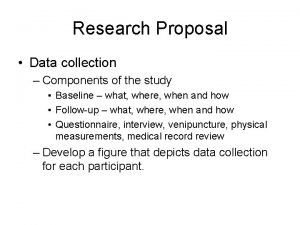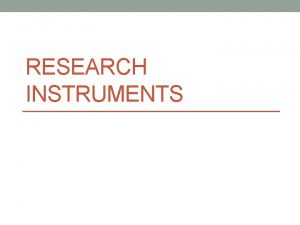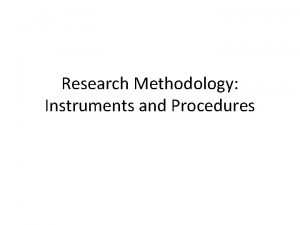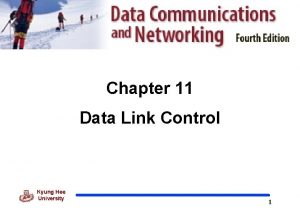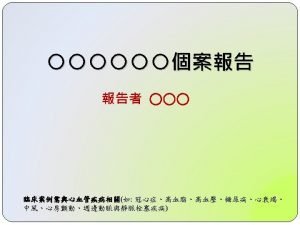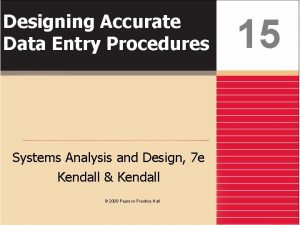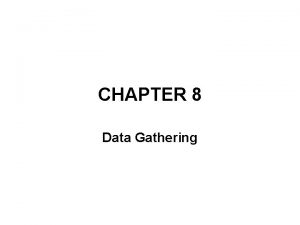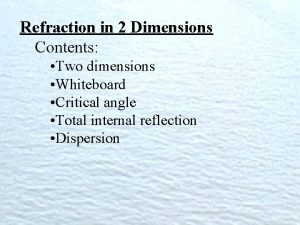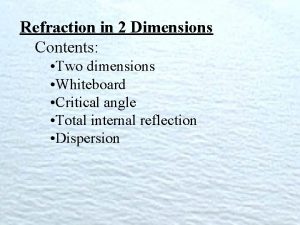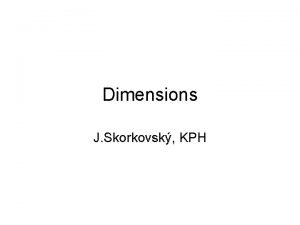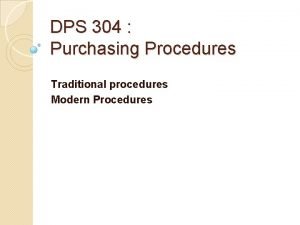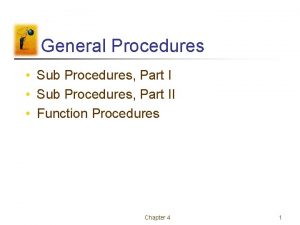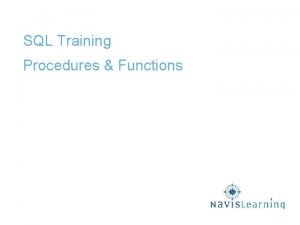Data Gathering Procedures Two dimensions on which we





















- Slides: 21

Data Gathering Procedures • Two dimensions on which we can distinguish data gathering procedures § The degree of contact between the researcher and the participant § The extent to which participants are given an opportunity to respond

Data Gathering Procedures • Dimensionalizing direct contact / response-gathering procedures Direct Contact Direct Response • Attitude scales • Questionnaires • Interviews Direct Contact No Response • Observational techniques No Contact No Response • Archival methods • Erosion/Accretion methods • Content analysis

Direct Contact / Direct Response • Different methods of interaction § Whether or not measure was disguised in its intent § The degree of structure imposed on participants’ responses

Direct Contact / Direct Response • Cross-tabulation of interaction types between researcher and participant Disguised More No • Information tests • Estimating group norms Less Structured Yes • Attitude scales • Thematic • Open-ended Apperception Test interviews and questionnaires • Rorschach

Direct Contact / Direct Response • The status of disguised measures § Peak of popularity was in 1950 s and 1960 s u A period when social sciences were obsessed with negative attitudes and behaviors like prejudice, obedience, conformity § Techniques emphasized control and structure, couple with deception § Techniques were probably oversold by researchers of the day § Less useful and predictive than nondisguised measures u “If you want to know something about someone, ask them; they might just tell you” (Kelly, 1955)

Direct Contact / Direct Response • Non-Disguised measures § Questionnaires and interviews § Means of questionnaire administration u Self-administered u Group-administered u Mail out § Means of interview administration u In-person interview u Focus-group interview u Telephone interview § Degree of structure u Open-ended questions u Close-ended/forced choice questions

Direct Contact / Direct Response • Advantages and disadvantages to interviews and questionnaires Advantages Interviews • More economical. Easier to give out 100 questionnaires than do 100 interviews • Data more immediate • People sometimes feel greater anonymity • Higher response rates (7080%) • In-depth probing • Don’t require literacy • Maximize seriousness of responses • Best for complex protocols Disadvantages Questionnaires • Return rates not always great (10 – 40%) • Lack of depth in probing of responses; you can’t tell if people misinterpret • Restricted utility because people must read/write • Time-consuming and expensive • Anonymity an issue: you need well-trained interviewers to build rapport • More reactive • Verbatim response? Paraphrase? Tape?

Direct Contact / Direct Response • Rating and Likert Scales § Rating scale: All things considered, how satisfied or dissatisfied are you with your life as a whole right now? 1 2 Completely Dissatisfied 3 4 5 6 7 Completely Satisfied § Likert (Likert-type) Scale: All things considered, I believe that the death penalty should be reinstated ___ Strongly disagree ___ Moderately disagree ___ Slightly disagree ___ Neutral ___ Slightly agree ___ Moderately agree ___ Strongly agree

No Contact / No Response • Unobtrusive measures § Physical trace measures u Erosion and accretion u Selective deposit and selective survival § Archival measures u Allow for longitudinal analysis u Archival sources actually exist u Lower cost u Less influenced by reactivity u Selective deposit and survival

Direct Contact / No Response • Observational techniques § What is an observation? u “The selection, provocation, recording, and encoding of that set of behaviors and organisms in situ which is consistent with empirical aims” (Weick, 1968)

Direct Contact / No Response • Methods of observational coding § What, who, and when to observer u What – Behavior sampling u Who – Subject sampling u When – Time sampling

Direct Contact / No Response • Methods of observational coding § Behavior sampling u Composite behavior u Syndrome u Simultaneous behaviors § Subject sampling

Direct Contact / No Response • Methods of observational coding § Time sampling u Why is time important? Behavior is expressed as a sequence of events Observational data is gathered over time Repeated observations are necessary The need to be able to differentiate individual differences

Direct Contact / No Response • Time sampling techniques § Semi-continuous sampling u Partial-interval sampling Divide observation period into equal time intervals Score behavior interval by interval 1 for occurrence, 0 for nonoccurrence Overestimates prevalence u Whole-interval sampling 0 for non-occurrence over entire interval; 1 for any occurrence Underestimates prevalence

Direct Contact / No Response • Time sampling techniques § Discrete sampling u Ad libitum sampling Record behaviors on a nonsystematic, informal basis Susceptible to observer bias Some behaviors attract attention u Momentary sampling Observe behavior at specific, predetermined point in time 1 if behavior occurred at that time, 0 if it did not occur Unbiased estimate of prevalence

Reliability of Observational Coding • Interobserver agreement indices § Smaller / Larger Index u Divide smaller of two values by larger of two values Observer 1: 9 vocalizations Observer 2: 10 vocalizations u Smaller/Larger Index = 9/10, 90% u Problem: Observer 1: 0 1 0 1 Observer 2: 1 0 1 0 S/L = 3/3 = 100% No individual observation agrees

Reliability of Observational Coding • Interobserver agreement indices § Percent agreement u Number of agreements divided by the number of agreements plus the number of disagreements Observer 1: 0 1 1 1 0 1 Observer 2: 0 1 1 0 0 1 u # of agree = 7, disagree = 3 u % agreement = 7 / (7+3) = 70% u Problem – inflation by chance

Reliability of Observational Coding • Interobserver agreement indices § Cohen’s Kappa u Discounts expected chance agreements u (Po – Pc) / (1 – Pc) Po = proportion agreement Pc = proportion expected by chance

Reliability of Observational Coding Percent agreement & Cohen’s Kappa 1 2 3 4 5 6 7 8 9 10 11 12 13 14 15 16 17 18 19 20 S S S F F F R S S S F R R R S R F R S S S R F F F R R S S S F F R R S F F F S: Success in barrier crossing F: Failure in barrier crossing R: Refusal in barrier crossing Percent agreement: # agree / (# agree + # disagree) Example: # agree: 7 (S) + 4 (F) + 3 (R) = 14 # disagree: 0( S) + 2 (F) + 3 (R) = 6 Percent agreement: 14 / (14 + 6) = 70%

Reliability of Observational Coding Percent agreement & Cohen’s Kappa 1 2 3 4 5 6 7 8 9 10 11 12 13 14 15 16 17 18 19 20 S S S F F F R S S S F R R R S R F R S S S R F F F R R S S S F F R R S F F F S: Success in barrier crossing F: Failure in barrier crossing R: Refusal in barrier crossing Percent agreement: 70% Cohen’s Kappa: (Po – Pc)/(1 – Pc) Po: Proportion agreement observed Pc: Proportion agreement expected by chance

Reliability of Observational Coding Percent agreement & Cohen’s Kappa 1 2 3 4 5 6 7 8 9 1 1 1 1 1 2 0 1 2 3 4 5 6 7 8 9 0 S S S F F F R S S S F R R R S R F R S S S R F F F R R S S S F F R R S F F F Percent agreement: 70% Cohen’s Kappa: (Po – Pc)/(1 – Pc) Observer 2 Success Observer 1 Failure Refusal Total 7 Failure 6 Refusal 7 8 5 20 Total 7 Po: (7 + 4 + 3) / 20 =. 70 Pc: ((7*7) + (6*8) + (7*5) / (20*20) = (49+4*+35)/400 =. 33 Kappa: (. 70 -. 33) / (1 -. 33) =. 5522
 Data gathering procedure in research example
Data gathering procedure in research example Words images objects qualitative or quantitative
Words images objects qualitative or quantitative Apa itu data requirement gathering
Apa itu data requirement gathering Data warehouse requirements gathering
Data warehouse requirements gathering Data gathering procedure
Data gathering procedure Five key issues of data gathering
Five key issues of data gathering Five key issues of data gathering
Five key issues of data gathering Data gathering procedure in research proposal
Data gathering procedure in research proposal What is research instrument
What is research instrument Methods of gathering data national 5 pe
Methods of gathering data national 5 pe 6.02 gathering weather data
6.02 gathering weather data Definition of terms in research
Definition of terms in research Example of data gathering procedure
Example of data gathering procedure Pe cycle of analysis
Pe cycle of analysis Problem 12-4 preparing a payroll check
Problem 12-4 preparing a payroll check Piggybacking in go-back-n arq
Piggybacking in go-back-n arq Procedures of data collection
Procedures of data collection Accurate data entry
Accurate data entry Biochemical data, medical tests, and procedures (bd)
Biochemical data, medical tests, and procedures (bd) Micrmark
Micrmark Acceleration in two dimensions
Acceleration in two dimensions Two dimensions of political ideologies
Two dimensions of political ideologies







